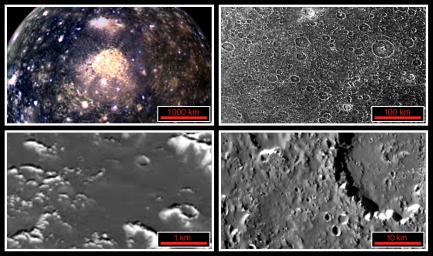These four views of Jupiter's second largest moon, Callisto, highlight how increasing resolutions enable interpretation of the surface. In the global view (top left) the surface is seen to have many small bright spots, while the regional view (top right) reveals the spots to be the larger craters. The local view (bottom right) not only brings out smaller craters and detailed structure of larger craters, but also shows a smooth dark layer of material that appears to cover much of the surface. The close-up frame (bottom left) presents a surprising smoothness in this highest resolution (30 meters per picture element) view of Callisto's surface.
North is to the top of these frames which were taken by the Solid State Imaging (SSI) system on NASA's Galileo spacecraft between November 1996 and November 1997. Even higher resolution images (better than 20 meters per picture element) of Callisto will be taken on June 30, 1999 during the 21st orbit of the spacecraft around Jupiter.
The top left frame is scaled to 10 kilometers (km) per picture element (pixel) and covers an area about 4400 by 2500 km. The moon Callisto, which has a diameter of 4806 km, appears to be peppered with many bright spots. Images at this resolution of other cratered moons in the Solar System indicate that the bright spots could be impact craters. The ring structure of Valhalla, the largest impact structure on Callisto, is visible in the center of the frame. This color view combines images obtained in November 1997 taken through the green, violet, and 1 micrometer filters of the SSI system.
The top right frame is ten times higher resolution (about 1 km per pixel) and covers an area approximately 440 by 250 km. Craters, which are clearly recognizable, appear to be the dominant landform on Callisto. The crater rims appear bright, while the adjacent area and the crater interiors are dark. This resolution is comparable to the best data available from the 1979 flyby's of NASA's two Voyager spacecraft; it reflects the understanding of Callisto prior to new data from Galileo. This Galileo image was taken in November 1996.
The resolution of the bottom right image is again ten times better (100 meters per pixel) and covering an area of about 44 by 25 km. This resolution reveals that some crater rims are not complete rings, but are composed of bright isolated segments. Steep slopes near crater rims reveal dark material that appears to have slid down to reveal bright material. The thickness of the dark layer could be tens of meters. The image was taken in June 1997.
The bottom left image at about 29 meters per pixel is the highest resolution available for Callisto. It covers an area about 4.4 by 2.5 km and is somewhat oblique. Craters are visible but no longer dominate the surface. The image was taken in November 1996.
The Jet Propulsion Laboratory, Pasadena, CA manages the Galileo mission for NASA's Office of Space Science, Washington, DC. JPL is an operating division of California Institute of Technology (Caltech).
This image and other images and data received from Galileo are posted on the World Wide Web, on the Galileo mission home page at URL http://galileo.jpl.nasa.gov. Background information and educational context for the images can be found at http://www.jpl.nasa.gov/galileo/sepo.

 Planetary Data System
Planetary Data System












